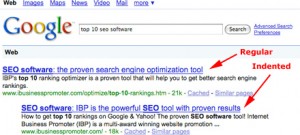Have you ever wondered how to get a double listing in Google? Some people refer to them as indented listings, either is fine. An indented listing is not often thought about during the web design process, but from a search perspective it can push your traffic through the roof.
A double listing is the culmination of two pages on your website ranking well for the same keyword. They don’t have to rank 1 and 2 for the keyword, but they do need to rank on the same page. When they do appear on the same page of the search results, Google uses the indented listing to show they’re from the same site. It’s really just an efficiency thing for Google.

So, how do you go about getting a double listing? As far as difficulty goes, it should be as difficult as it was to get your first page ranked for that keyword. And then just a smidge harder.
If you want a formula, start with the title tag and description tag. For the page of your site that currently ranks on the first page of Google, how often does your keyword occur in both of these, and what percent of the total tag is your keyword? Figure that out, then write a title tag and description tag for a second page that matches the number and density.
The key here is to use the same keyword, but write a different title and description.
The next phase is to analyze the components of the webpage itself. On the page currently ranked, what is the density of your keyword and where in the page does it occur? You’ll want to mimic both the density and placement on the second page. But again, keep in mind the rest of the content needs to be different. Just keep the numbers the same.
That was the easy part.
And the hard part. . . maybe. . . where are the links coming from that are going to the original page? Backlinks? Blog links? Other interior page links? One way links? anchor text links? etc. . . (You may want to use Market Samurai or the SEO Quake tool bar to help figure this out).
Once you do figure this out in a quantitative way, the goal is to mimic what you did on the first – without using the same sites. You can use some of the same sites to link to the second page – but ultimately you’ll want different links with simliar pagerank.
The folks at Google aren’t idiots. They may just notice if everything is duplicated. The key here is to create a natural web of links to both pages. And the second key is to have the patience to not expect results tomorrow. Do these things then wait a bit and see what happens.
If you’ve had luck with double or even triple listings – and have a “secret”, we’d love to hear it.

![Reblog this post [with Zemanta]](https://img.zemanta.com/reblog_e.png?x-id=6d347da3-cb72-40ce-945b-d21b0d235e29)